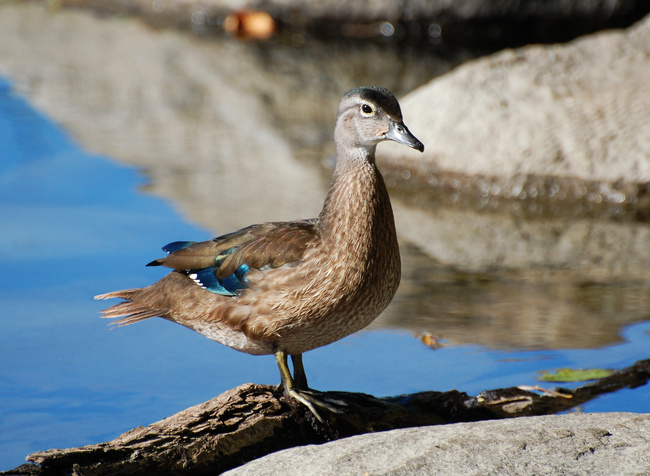
Poise
October 1st, 2009

Juvenile Wood Duck, on the Rideau a few weeks ago.
It was a brisk morning at Andrew Haydon Park yesterday, with cold temperatures, strong winds and an occasional dousing of rain. I found it invigorating--at least until I'd been out in it for four hours, after which, I was pretty much done! The water level on the Ottawa River has finally gone down substantially, exposing habitat (i.e. mud flats) for sandpipers and plovers. Killdeer were foraging in the mud at the west end of the park, along with several Spotted Sandpipers and a pair of Lesser Yellowlegs. The usually Mallards in that area were joined by a small group of Blue-Winged Teal, and one male Gadwall. I can count on one hand the number of times I've seen Gadwalls, and I love their silvery plumage, so that was exciting.
The Brant has been at the park all summer and now into fall. I'm beginning to wonder when and if he'll leave. Ottawa winter would be hard on him.
Around midday another birder game along, toting scope and binoculars. I asked for his help to confirm (or correct) my ID on the Lesser Yellowlegs, he did, and we introduced ourselves and got to chatting. He had glimpsed an unusual songbird he couldn't identify back at Dick Bell Park, walking on the rocks. The bird flushed, but he figured now that he'd been gone awhile, it might be back. So we headed over there to search for it. (Dick Bell Park is a.k.a. Nepean Sailing Club and is within walking distance west of Andrew Haydon. It's known to birders primarily as A. home to a thriving Purple Martin colony, B. a place where you might see a Purple Sandpiper in early November, and C. a place where you might see an ultra-rare Northern Wheatear, if fate smiles on you.)
We finally found a Horned Lark, of all things! He was out on the jetty flitting among the rocks like a sandpiper, and occasionally walking on the lawn. Horned Larks are birds of open country (and because I have little experience birding open country, I'd never seen one before), so I was surprised to find him there--I'm pretty sure there is no "D. place for seeing horned larks" in anyone's book! Earlier that day I had seen a small bird with undulating flight over the river, likely the same one. We suspected that he was in mid-migration, the strong winds that morning grounded him, and he just dropped down to the nearest land he could find.
On Friday morning I go back with my camera, and hope to have the kind of luck I did today.
October 1st, 2009

Juvenile Wood Duck, on the Rideau a few weeks ago.
It was a brisk morning at Andrew Haydon Park yesterday, with cold temperatures, strong winds and an occasional dousing of rain. I found it invigorating--at least until I'd been out in it for four hours, after which, I was pretty much done! The water level on the Ottawa River has finally gone down substantially, exposing habitat (i.e. mud flats) for sandpipers and plovers. Killdeer were foraging in the mud at the west end of the park, along with several Spotted Sandpipers and a pair of Lesser Yellowlegs. The usually Mallards in that area were joined by a small group of Blue-Winged Teal, and one male Gadwall. I can count on one hand the number of times I've seen Gadwalls, and I love their silvery plumage, so that was exciting.
The Brant has been at the park all summer and now into fall. I'm beginning to wonder when and if he'll leave. Ottawa winter would be hard on him.
Around midday another birder game along, toting scope and binoculars. I asked for his help to confirm (or correct) my ID on the Lesser Yellowlegs, he did, and we introduced ourselves and got to chatting. He had glimpsed an unusual songbird he couldn't identify back at Dick Bell Park, walking on the rocks. The bird flushed, but he figured now that he'd been gone awhile, it might be back. So we headed over there to search for it. (Dick Bell Park is a.k.a. Nepean Sailing Club and is within walking distance west of Andrew Haydon. It's known to birders primarily as A. home to a thriving Purple Martin colony, B. a place where you might see a Purple Sandpiper in early November, and C. a place where you might see an ultra-rare Northern Wheatear, if fate smiles on you.)
We finally found a Horned Lark, of all things! He was out on the jetty flitting among the rocks like a sandpiper, and occasionally walking on the lawn. Horned Larks are birds of open country (and because I have little experience birding open country, I'd never seen one before), so I was surprised to find him there--I'm pretty sure there is no "D. place for seeing horned larks" in anyone's book! Earlier that day I had seen a small bird with undulating flight over the river, likely the same one. We suspected that he was in mid-migration, the strong winds that morning grounded him, and he just dropped down to the nearest land he could find.
On Friday morning I go back with my camera, and hope to have the kind of luck I did today.
| ← | → |
